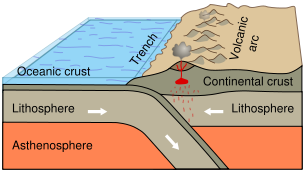Image:Oceanic-continental convergence Fig21oceancont.svg
From Wikipedia, the free encyclopedia

Oceanic-continental_convergence_Fig21oceancont.svg (SVG file, nominally 305 × 171 pixels, file size: 52 KB)
SVG conversion of Image:Oceanic-continental convergence Fig21oceancont.gif
Licensing
 |
I, the copyright holder of this work, hereby release it into the public domain. This applies worldwide. In case this is not legally possible, |
 |
This image is a work of a United States Geological Survey employee, taken or made during the course of the person's official duties. As a work of the United States Government, the image is in the public domain. For more information, see the USGS copyright policy. See Wikipedia:Public domain and Wikipedia:Copyrights for more details. | |
In an oceanic-continental boundary, the two plates (the oceanic plate and the continental plate) ram into each other, causing the oceanic plate to subduct beneath the continental plate because of the difference in density. The magma under the Earth’s surface is less dense than the oceanic plate running into it, so it rises and forms a chain of volcanoes on the surface of the continental plate. This chain of volcanoes is called a volcanic arc, and it is usually a few hundred miles inland from the plate boundary. In addition to volcanic arcs, deep trenches are also created and earthquakes become more frequent as well.
File history
Click on a date/time to view the file as it appeared at that time.
| Date/Time | Dimensions | User | Comment | |
|---|---|---|---|---|
| current | 01:49, 21 May 2006 | 305×171 (52 KB) | Booyabazooka ( Talk | contribs) | (cropped version) |
| revert | 01:46, 21 May 2006 | 400×300 (50 KB) | Booyabazooka ( Talk | contribs) | (SVG conversion of Image:Oceanic-continental convergence Fig21oceancont.gif ==Licensing== {{PD-self}} {{PD-USGov-Interior-USGS}}) |
See the setup instructions for more information.
File links
The following file is a duplicate of this file: